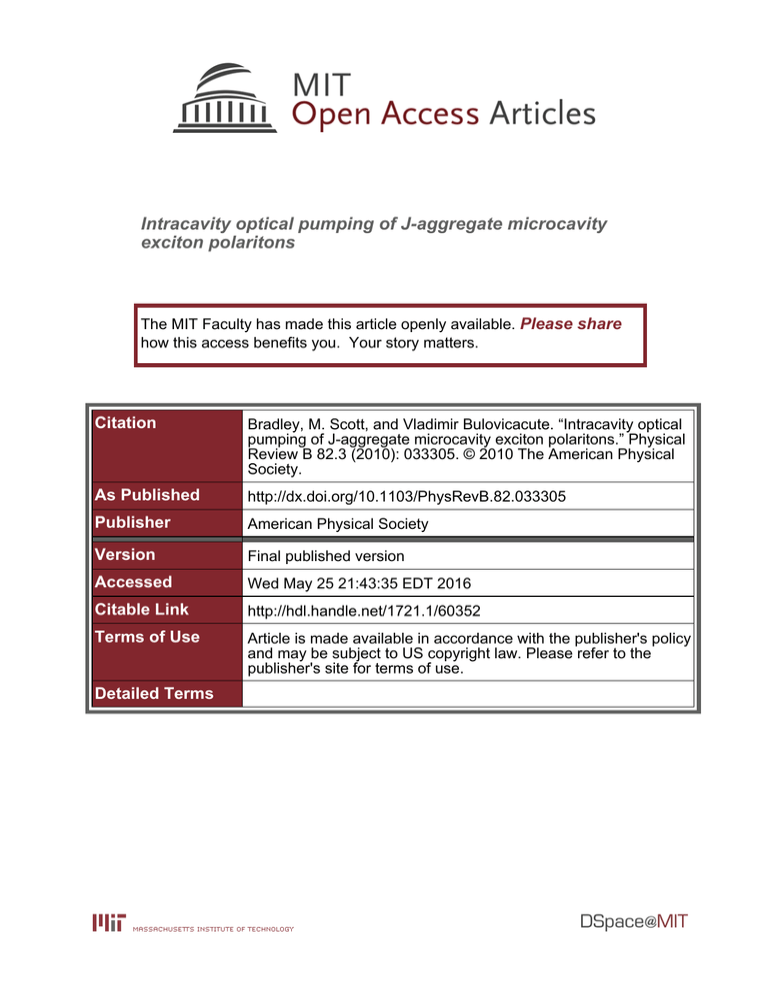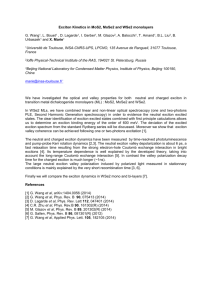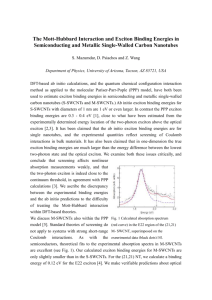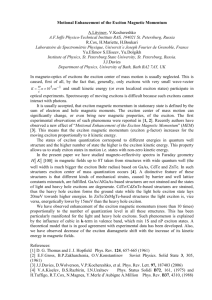Intracavity optical pumping of J-aggregate microcavity exciton polaritons Please share
advertisement

Intracavity optical pumping of J-aggregate microcavity
exciton polaritons
The MIT Faculty has made this article openly available. Please share
how this access benefits you. Your story matters.
Citation
Bradley, M. Scott, and Vladimir Bulovicacute. “Intracavity optical
pumping of J-aggregate microcavity exciton polaritons.” Physical
Review B 82.3 (2010): 033305. © 2010 The American Physical
Society.
As Published
http://dx.doi.org/10.1103/PhysRevB.82.033305
Publisher
American Physical Society
Version
Final published version
Accessed
Wed May 25 21:43:35 EDT 2016
Citable Link
http://hdl.handle.net/1721.1/60352
Terms of Use
Article is made available in accordance with the publisher's policy
and may be subject to US copyright law. Please refer to the
publisher's site for terms of use.
Detailed Terms
PHYSICAL REVIEW B 82, 033305 共2010兲
Intracavity optical pumping of J-aggregate microcavity exciton polaritons
M. Scott Bradley and Vladimir Bulović*
Organic and Nanostructured Electronics Laboratory, Center for Excitonics, Massachusetts Institute of Technology,
Cambridge, Massachusetts 02139, USA
共Received 30 March 2010; revised manuscript received 23 June 2010; published 29 July 2010兲
We demonstrate intracavity optical pumping of J-aggregate microcavity exciton polaritons. The use of
ultrathin layer-by-layer J-aggregate thin films as the strongly coupled exciton medium allows for inclusion of
a thermally evaporated luminescent cavity spacer layer, through which the lower-branch exciton-polariton
states are resonantly pumped. We present a measurement of the lower-branch exciton-polariton occupation in
room-temperature microcavity devices containing J-aggregated molecular thin films under low-density steadystate excitation. The observed exciton-polariton occupation shows a Maxwell-Boltzmann distribution at T
= 300 K, indicating thermalization of exciton polaritons in the lower energy branch. This device design enables
us to propose a new type of “polariton laser” architecture for microcavity exciton polaritons.
DOI: 10.1103/PhysRevB.82.033305
PACS number共s兲: 78.55.Kz, 71.36.⫹c, 81.05.Fb
Microcavity structures containing organic thin films can
manifest strong coupling of light and matter even at roomtemperature conditions due to the large oscillator strength
and high-binding energy of the Frenkel exciton transitions in
organic molecular thin films.1–4 The ease of incorporating
room-temperature-deposited layered organic materials into
microcavity devices enabled the first demonstration of electroluminescence of microcavity exciton polaritons from an
organic light-emitting device containing a thin film of the
strongly coupled organic material.5 Inorganic excitonpolariton devices have been used to demonstrate coherent
light emission from optically pumped lower-branch excitonpolariton states,6–9 which may be a first indication of the
superfluidity that has been theoretically predicted for microcavity exciton polaritons. Such polariton lasing was recently
demonstrated in an organic exciton-polariton system, where
microcavity photons were strongly coupled to crystalline
anthracene.10 In both inorganic and organic systems, populating the lower-branch exciton polariton from uncoupled excitons 共the “exciton reservoir”兲 is a challenge.11–13 The
present study introduces a method of populating lowerbranch J-aggregate microcavity exciton polaritons via intracavity optical pumping from an organic dye-doped luminescent spacer layer. At low-optical-pumping intensities the
measured occupation of exciton polaritons in the lowerbranch fits a Maxwell-Boltzmann distribution at T = 300 K,
indicating that the polariton population is thermalized. We
suggest a novel means of achieving polariton lasing in
exciton-polariton devices and examine current literature on
expected thresholds in organic exciton-polariton lasers.
Considerable theoretical research has examined the nature
of exciton polaritons in both crystalline and disordered organic microcavities.14–17 One key result of this research is
that exciton polaritons near k储 = 0 in the lower polariton
branch in organic systems are localized due to resonant scattering and structural inhomogeneities, similar to the disorderinduced localization of polaritons in GaN quantum-well
systems.18,19 One of the effects of localization is that only a
subset of excitonic states are strongly coupled to the normal
mode of the microcavity, and population of the lower-branch
exciton polaritons from uncoupled excitons via phononassisted scattering is limited.20–23 In the recently reported
1098-0121/2010/82共3兲/033305共4兲
result of polariton lasing in crystalline anthracene microcavities, the authors attribute sufficient population of the lower
branch to photoluminescence from uncoupled excitons in anthracene, a pathway, which has recently been theoretically
studied.10,24 Based on these earlier results, we suggest that
J-aggregate microcavities, specifically with thin films of
J-aggregates grown through the layer-by-layer 共LBL兲
method, allow for deliberate intracavity optical pumping of
lower-branch exciton-polariton states through the use of a
luminescent cavity spacer layer.
The structure of devices measured in this study is shown
in Fig. 1共a兲. A microcavity is formed using two distributed
Bragg reflectors 共DBRs兲 consisting of alternating pairs of
layers of silicon dioxide 共SiO2兲 and titanium dioxide 共TiO2兲.
The bottom, 14.5-pair TiO2 / SiO2 DBR was commercially
obtained from Visimax Technologies and was deposited via
plasma-enhanced evaporation. The top, 10-pair TiO2 / SiO2
DBR was deposited using automated radio-frequency sputtering; the TiO2 was deposited in pure argon plasma, and the
SiO2 was deposited in argon plasma with 15% oxygen. The
bottom cavity spacer is a sputter-deposited SiO2 layer,
共128.4⫾ 0.3兲 nm thick 共measured on a Gaertner ellipsometer兲, deposited using the same conditions as the SiO2 layers
in the top DBR. The J-aggregate thin film is deposited
through spin self-assembly 共SSA兲 of alternating layers of
PDAC 关poly共diallyldimethylammonium chloride兲, MW 4
⫻ 105, obtained from Sigma Aldrich, CAS 26062–79–3兴 and
THIATS 关Benzothiazolium, 5-chloro-2-关2-关关5-chloro-3-共3sulfopropyl兲-2共3H兲-benzothiazolylidene兴methyl兴-1-buten-1yl兴-3-共3-sulfopropyl兲-, inner salt, compounded with N,Ndiethylethanamine 共1:1兲 obtained from H.W. Sands, CAS
23568–98–1兴. The THIATS solution used in the SSA process
had a concentration of 100 uM in deionized 共DI兲 water, made
by diluting a 2 mg/mL stock solution in DI water. The PDAC
solution was 3 mM in DI water.
SSA of polyelectrolyte thin films was first introduced in
the early 2000s and has been utilized to make both thin films
comprised of all polyelectrolytes and thin films of polyelectrolytes and oppositely charged particles 共quantum dots, molecules, etc.兲.25–28 The process is similar to the LBL process
in theory of operation, where oppositely charged layers are
sequentially adsorbed with the excess loosely bound material
033305-1
©2010 The American Physical Society
N
O Al O
N
NO
Top DBR
Mirror
N
O
N
J-Aggregate Thin Film:
{
Alq 3:DCM Spacer
SiO2 Spacer
Boom DBR
Mirror
TiO2/SiO2
SiO2 Substrate
b)
PDAC
Cl
THIATS
n
N+ ClS
+
N
N
SO 3-
Cl
SO3H
3.0
2.5
2.0
THIATS
0.8
0.6
0.4
0.2
0.0
Alq3
Posion, Y (mm)
2.2
Cav 2.1
2
Ex
650
LB
1.9
n cav =1.8
1.8
700
1.7
750
0 10 20 30 40 50
b)
600 UB
Angle (degree)
Absorbance
DCM
3.0
Photoluminescence
Typical DBR
Stopband Edges
400
2
Ex 1.9
1.8
1.7
750
8 10 12 14 16 18 20
Wavelength (nm)
1.0
80 meV 2.2
2.1
650 LB
Cav
700
S
Energy (eV)
3.5
550
a) Ω =
600 UB R
500 600 700
Wavelength (nm)
FIG. 1. 共a兲 Graded-thickness microcavity device structure and
molecular diagrams of constituent thin film materials. 共b兲 Normalized absorbance 共Abs兲 and photoluminescence 共PL兲 spectra of Alq3,
DCM, and THIATS J-aggregates showing spectral overlaps governing energy down conversion from Alq3 through DCM to THIATS
J-aggregates.
rinsed, allowing for nanoscale thickness precision for deposited films. In LBL, the substrates are immersed in growth
and rinse solutions, whereas in SSA, these solutions are
poured on the substrate, followed by spinning of the substrate to dry. For growing only a few thin film samples, SSA
is faster than a comparable LBL process and prevents crosscontamination of growth solutions. A hybrid process of SSA
and a few LBL immersion steps can also be performed to
allow deposition of J-aggregate thin films using less-watersoluble dyes than THIATS, such as TDBC, the J-aggregating
dye used in the electroluminescence studies referenced
above.5,29
After the J-aggregate thin film is deposited on top of the
bottom DBR, a luminescent top cavity spacer of varying
thickness is thermally evaporated, consisting of Alq3 关aluminum tris共8-hydroxyquinoline兲兴 doped at 2% to 3% by weight
with the laser dye DCM 关4-共dicyanomethylene兲-2-methyl-6共4-dimethylaminostyryl兲-4H-pyran兴. The varying thickness
of the spacer layer across the substrate 关as sketched in Fig.
1共a兲兴 is achieved by evaporating the Alq3 : DCM thin film
through a fixed shadow mask onto a rotating substrate. The
use of a luminescent Alq3 : DCM top cavity spacer allows for
intracavity pumping of the THIATS J-aggregate microcavity
exciton polaritons, as shown by the absorption and PL spectra of the various materials in the microcavity in Fig. 1共b兲.
For PL measurements, the samples are pumped using a 4
mW = 408 nm CW laser focused into a ⬍ 100 m diam-
4.0
log10(Counts) (arb. units)
5.0
620
Cavity 2
c) UB
1.975
630
Exciton
1.95
640
LB
1.925
650
1.9
660
1.875
0 5 10 15 20 25 30 35
Energy (eV)
λ(y)
2n
y
550
Energy (eV)
N
TiO2/SiO2
Normalized Abs.,PL (arb. units)
DCM (2-3%)
Wavelength (nm)
Alq3
Probe θ
Wavelength (nm)
a)
Energy (eV)
PHYSICAL REVIEW B 82, 033305 共2010兲
BRIEF REPORTS
Angle (degree)
0
400
800
1200
1600
2000
Counts (arb. units)
FIG. 2. 共Color online兲 共a兲 PL spectrum versus position on
sample with energies of lower-branch 共LB兲 and upper-branch 共UB兲
exciton-polariton modes, uncoupled cavity mode found with numerical fit 共Cav兲, and uncoupled J-aggregate exciton 共Ex兲. 共b兲 PL
spectrum versus angle at position Y ⬃ 10 mm on sample using lowresolution grating. 共c兲 PL spectrum versus angle at same position as
in 共b兲 using high-resolution grating.
eter spot, which excites the Alq3 and subsequently DCM
through Förster transfer; the DCM then excites the THIATS
exciton and exciton-polariton states through direct Förster
transfer or through absorption of DCM PL by THIATS, depending on the proximity of the excited DCM molecules to
the THIATS J-aggregate thin film. Angle-resolved PL is collected using a multimode optical fiber mounted on a custombuilt automated rotation stage with ⬍0.5° resolution. The
excitation laser strikes the sample at a 45° incident angle; a
slight downward tilt to the optic axis is used to avoid collection of the reflected excitation beam by the fiber.
Figure 2 shows the PL intensity collected from the sample
shown in Fig. 1共a兲 as a function of position on the sample
surface, with the PL collected at normal incidence 共i.e., k储
= 0兲 关Fig. 2共a兲兴 and as a function of angle of light collection
away from the normal 关Fig. 2共b兲 and 2共c兲兴. The exciton reso-
033305-2
PHYSICAL REVIEW B 82, 033305 共2010兲
BRIEF REPORTS
Scaled Counts (arb. units)
a)
1
1
E⫾ = 共Ecav + EJ-Agg兲 ⫾ 冑ប2⍀R2 + 共Ecav − EJ-Agg兲2 , 共1兲
2
2
where E+/− are the upper and lower-branch exciton-polariton
eigenenergies, Ecav is the energy of the cavity resonance corresponding to cav = hc / Ecav, EJ-Agg is the exciton resonance
corresponding to the J-Agg, and ប⍀R is the Rabi splitting,
with ប⍀R = 80 meV used for the fit.
Figure 2共b兲 shows the angle-resolved PL at nearly-zero
detuning 关position Y ⬃ 10 mm on the Fig. 2共a兲 plot兴. Note
that the PL intensity in this figure is plotted on a logarithmic
color chart, as indicated. Replacing Ecav in Eq. 共1兲 with the
angle-dependent cavity resonance given by
冑
1−
sin2
,
3600
M-BDist.
T=300K
3200
2800
2400
2000
Lower-Branch
PL Peak
1.928 1.932 1.936 1.940 1.944 1.948
Energy(eV)
b)
共2兲
Lower-Branch Fracon
Ecav共兲 =
Ecav共0°兲
Wavelength(nm)
644 643 642 641 640 639 638
1.0
1.948
Photon
Exciton
0.8
1.944
0.6
1.940
0.4
1.936
0.2
1.932
0.0
0
5
10
15
1.928
20
Lower-BranchEnergy(eV)
nance 共i.e., the ground state to one-exciton transition of the
J-aggregate兲 is assumed to be at a free-space wavelength of
J-Agg = 630 nm. The wavelength of the cavity resonance,
cav, is calculated at each position by fitting the observed
peak in the lower-branch exciton-polariton PL to that predicted by the coupled light and two-level system eigenenergy
equation:
Angle(degree)
n2ef f
with corresponding to the light-emission angle away from
the sample normal, we can fit the angular dispersion of the
lower-branch exciton-polariton PL peak, finding the effective
index of refraction of the cavity to be nef f = 1.8. Note that
luminescence of DCM via the low-energy DBR Bragg
modes in the wavelength range of = 650 nm to
= 725 nm is also visible in the measured PL in Fig. 2共b兲, and
at large angles the intensity increases due to the collection of
waveguided emission in the far-field optical setup. Figure
2共c兲 plots the lower-branch exciton-polariton PL measured
using a spectrometer grating with ⬃0.05 nm wavelength
resolution on a more limited set of angles to avoid collecting
waveguided emission, with the PL intensity plotted on a linear color chart, as indicated.
The measured intensity of the lower-branch excitonpolariton PL, shown in Fig. 2共c兲, is converted to a relative
occupation number of the corresponding exciton-polariton
states by taking account of both the effect of the multilayer
planar structure on the observed emission intensity and the
effect of the changing composition of the exciton polariton
from photon to exciton due to the larger positive detuning of
the cavity resonance from the exciton resonance as the emission angle increases. The former is an effect of Snell’s law
and is corrected by dividing the observed counts by the cosine of the observation angle 共as in Lambert’s Cosine Law兲.12
The latter is corrected by calculating the Hopfield coefficients at each angle and then dividing the observed counts at
each angle by the respective photon fraction.30 Figure 3共a兲
shows the observed counts of the lower-branch excitonpolariton PL 共scaled to correct for the above effects兲 together
with a superimposed plot of the Maxwell-Boltzmann 共M-B兲
distribution at T = 300 K. Figure 3共b兲 shows the photon and
exciton fraction of the lower-branch calculated from the
Hopfield coefficients and used in the scaling of the counts in
FIG. 3. 共a兲 Relative lower branch exciton-polariton occupation
indicated by scaled PL counts versus energy. PL counts are scaled
by photon fraction versus angle and account for change in observed
internal solid angle as the measurement angle changes. The solid
line is a Maxwell-Boltzmann distribution at T = 300 K. 共b兲 Calculated photon and exciton fractions of the lower-branch exciton
polariton versus angle along with energy of the peak in lowerbranch PL versus angle.
Fig. 3共a兲. The good agreement between the measured lowerbranch exciton-polariton relative occupation and the M-B
distribution at T = 300 K indicates that the exciton polaritons
pumped into the lower-branch have thermalized prior to decay.
Use of the optically pumped luminescent spacer layer to
inject exciton polaritons into the strongly coupled microcavity, which is then followed by the exciton-polariton thermalization in the lower branch, suggests a device architecture for
a “polariton laser.” With sufficiently high reflectance of the
microcavity mirrors, and a sufficient thickness of the luminescent cavity spacer gain material, the spacer material could
undergo lasing in an exciton-polariton mode.
Although exciton-polariton lasers are generally expected
to have a lower threshold than traditional vertical-cavity
surface-emitting lasers 共VCSELs兲, based on current literature, a comparison of the expected threshold of an organic
VCSEL to that of an organic exciton-polariton laser is complicated by the lack of studies specific to organic excitonpolariton systems. Litinskaya et al. estimated a low threshold
for organic exciton-polariton lasing relative to organic
VCSELs by using the density of states of a planar microcavity to determine occupation threshold, but not accounting for
the effect of dephasing on condensation, which has been
studied at length in inorganic systems.31,32 From the literature on inorganic exciton-polariton systems, one might com-
033305-3
PHYSICAL REVIEW B 82, 033305 共2010兲
BRIEF REPORTS
pare GaN-quantum-well systems to organic systems since
both are operated at room temperature and have similar Rabi
splittings 共30–150 meV兲 and exciton linewidths 共15–50
meV兲,33,34 but some important distinctions remain. For example, the threshold of a quantum-well GaN-based excitonpolariton system, recently predicted theoretically, was 3
⫻ 1012 excitations per cm2, which corresponds to one exciton
polariton per 5.7⫻ 5.7 nm2.35 Such a length scale is comparable to the Förster radius for molecule-to-molecule exciton
energy transfer and to the exciton diffusion length of many
molecular organic thin films, especially those with considerable spectral overlap of emission and absorption which are
typically used in exciton-polariton devices. This proximity in
length scale necessitates that dipole-dipole interactions, such
as present in exciton energy transfer and exciton-exciton annihilation, must be explicitly taken into account.36,37 For
comparison, assuming that a pump photon energy is 3 eV,
then 3 ⫻ 1012 excitations per cm2 would correspond to the
lasing threshold energy density of Eth ⬃ 1 J cm−2, which is
two orders of magnitude lower than demonstrated for organic
VCSELs, to date.38 Note that a high peak pump power
共⬃1 MW cm−2兲 would be required for exciting the exciton-
*bulovic@mit.edu
1
D. G. Lidzey, D. D. C. Bradley, M. S. Skolnick, T. Virgili, S.
Walker, and D. M. Whittaker, Nature 共London兲 395, 53 共1998兲.
2
D. G. Lidzey, D. D. C. Bradley, T. Virgili, A. Armitage, M. S.
Skolnick, and S. Walker, Phys. Rev. Lett. 82, 3316 共1999兲.
3 J. R. Tischler, M. S. Bradley, Q. Zhang, T. Atay, A. Nurmikko,
and V. Bulovic, Org. Electron. 8, 94 共2007兲.
4
R. J. Holmes and S. R. Forrest, Org. Electron. 8, 77 共2007兲.
5 J. R. Tischler, M. S. Bradley, V. Bulovic, J. H. Song, and A.
Nurmikko, Phys. Rev. Lett. 95, 036401 共2005兲.
6 J. Kasprzak et al., Nature 共London兲 443, 409 共2006兲.
7 S. Utsunomiya, L. Tian, G. Roumpos, C. W. Lai, N. Kumada, T.
Fujisawa, M. Kuwata-Gonokami, A. Loffler, S. Hofling, A.
Forchel, and Y. Yamamoto, Nat. Phys. 4, 700 共2008兲.
8 A. Amo, et al., Nature 共London兲 457, 291 共2009兲.
9 H. Deng, H. Haug, and Y. Yamamoto, Rev. Mod. Phys. 82, 1489
共2010兲.
10 S. Kéna-Cohen and S. R. Forrest, Nat. Photonics 4, 371 共2010兲.
11 F. Tassone, C. Piermarocchi, V. Savona, A. Quattropani, and P.
Schwendimann, Phys. Rev. B 56, 7554 共1997兲.
12 F. Stokker-Cheregi, A. Vinattieri, F. Semond, M. Leroux, I. R.
Sellers, J. Massies, D. Solnyshkov, G. Malpuech, M. Colocci,
and M. Gurioli, Appl. Phys. Lett. 92, 042119 共2008兲.
13 J. Chovan, I. E. Perakis, S. Ceccarelli, and D. G. Lidzey, Phys.
Rev. B 78, 045320 共2008兲.
14
V. M. Agranovich, M. Litinskaia, and D. G. Lidzey, Phys. Status
Solidi B 234, 130 共2002兲.
15 M. Litinskaya, P. Reineker, and V. M. Agranovich, Phys. Status
Solidi A 201, 646 共2004兲.
16
P. Michetti and G. L. Rocca, Phys. Rev. B 71, 115320 共2005兲.
17 M. Litinskaya, Phys. Lett. A 372, 3898 共2008兲.
18
M. Litinskaya and P. Reineker, Phys. Rev. B 74, 165320 共2006兲.
19 D. Solnyshkov, H. Ouerdane, M. Glazov, I. Shelykh, and G.
Malpuech, Solid State Commun. 144, 390 共2007兲.
20 M. Litinskaya, P. Reineker, and V. Agranovich, J. Lumin. 110,
polariton laser, with even higher power needed than for organic VCSELs, owing to the short photon lifetime of
⬃ 1 ps in the cavity.39 The short cavity photon lifetime also
governs the excited state lifetime of exciton polaritons,
which inhibits their diffusion, and inadvertent polaritonpolariton annihilation.
In conclusion, we demonstrated intracavity optical pumping of exciton polaritons in J-aggregate microcavity systems
using a luminescent cavity spacer layer and show that the
occupation of the lower-branch exciton polaritons in such a
system at room temperature is thermalized, with relative occupation following a Maxwell-Boltzmann distribution at T
= 300 K. We suggest that a type of “polariton laser” could be
fabricated in organic systems by making a VCSEL whose
gain material is the luminescent cavity spacer layer and
which lases in a strongly coupled exciton-polariton mode.
M.S.B. acknowledges the support of the Department of
Defense. The work was supported by the U.S. Department of
Energy, Office of Basic Energy Sciences as part of the MIT
Energy Frontier Research Center on Excitonics.
364 共2004兲.
M. Litinskaya, P. Reineker, and V. Agranovich, J. Lumin. 119120, 277 共2006兲.
22
P. Michetti and G. C. La Rocca, Phys. Rev. B 77, 195301
共2008兲.
23 P. Michetti and G. C. La Rocca, Phys. Rev. B 79, 035325
共2009兲.
24
L. Mazza, L. Fontanesi, and G. C. La Rocca, Phys. Rev. B 80,
235314 共2009兲.
25
J. Cho, K. Char, J.-D. Hong, and K.-B. Lee, Adv. Mater. 13,
1076 共2001兲.
26 P. A. Chiarelli et al., Adv. Mater. 13, 1167 共2001兲.
27
V. E. Campbell, P. A. Chiarelli, S. Kaur, and M. S. Johal, Chem.
Mater. 17, 186 共2005兲.
28 J. Park, L. D. Fouche, and P. T. Hammond, Adv. Mater. 17, 2575
共2005兲.
29 M. S. Bradley, J. R. Tischler, and V. Bulovic, Adv. Mater. 17,
1881 共2005兲.
30 A. Kavokin, J. J. Baumberg, G. Malpuech, and F. P. Laussy,
Microcavities 共Oxford University Press, Oxford, 2007兲.
31 M. Litinskaya and P. Reineker, J. Lumin. 122-123, 418 共2007兲.
32 F. M. Marchetti, M. H. Szymanska, P. R. Eastham, B. D. Simons,
and P. B. Littlewood, Solid State Commun. 134, 111 共2005兲.
33 G. Christmann, R. Butte, E. Feltin, J. F. Carlin, and N. Grandjean, Phys. Rev. B 73, 153305 共2006兲.
34
S. Christopoulos et al., Phys. Rev. Lett. 98, 126405 共2007兲.
35 D. Solnyshkov, H. Ouerdane, and G. Mapuech, J. Appl. Phys.
103, 016101 共2008兲.
36
A. A. Shoustikov, Y. You, and M. E. Thompson, IEEE J. Sel.
Top. Quantum Electron. 4, 3 共1998兲.
37 J. Mei, M. S. Bradley, and V. Bulovic, Phys. Rev. B 79, 235205
共2009兲.
38 V. Bulović, V. G. Kozlov, V. B. Khalfin, and S. R. Forrest, Science 279, 553 共1998兲.
39 V. G. Kozlov et al., J. Appl. Phys. 84, 4096 共1998兲.
21
033305-4


![Supporting document [rv]](http://s3.studylib.net/store/data/006675613_1-9273f83dbd7e779e219b2ea614818eec-300x300.png)


